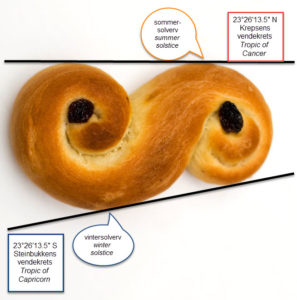Many kids will appear as “lucifers” today – light bearers. Celebration of Santa Lucia’s day seems to have won increasing popularity in Norway over the recent decades. Much of this cultural practice has clearly spread from Sweden, where the tradition is so deeply rooted since early 1900 that Swedish racists seem to believe that Lucia was an Arian blonde from remote mythical times of Astrid Lindgren’s Småland? But according to legend, Lucia was a christian martyr from Sicily in the fourth century. The story goes that she was tortured because of her conviction. She obtained her post mortem status as a heroine because she sacrificed her eyes for the “true faith” and was thus expelled to the darkness.

“Lussekatt” is a pastry made for Santa Lucia day. Is it supposed to express the track of the sun through the year?
Norwegian Wikipedia (of “Luciadagen”) claims that Lucia day has no actual association with Advent. “It is simply a celebration in commemoration of Sta. Lucia’s death on the 13th of December”, it is stated. But wait a minute! Take some time to look at the two calendars from the year 1700 that I reconstructed with the Timeanddate facility. This was the year when the Gregorian calendar revision was finally introduced in Denmark-Norway. Until that time Scandinavians had used the calendar that Julian Caesar’s government introduced 45 BC.

Reconstructed calendars for Denmark-Norway and Sweden from the year 1700. Notice that Norwegian Christmas Eve and Swedish Santa Lucia day are on the same day,
The Julian calendar is assuming a mean year length of 365.25 days, so the Julian clock was ticking about 20 minutes too fast compared to the mean tropical year. The Earth moves around the sun with a speed of about 30 km per second. As observed from the Earth, the mean time it takes for the Sun to return to the same point in the annual revolution is the tropical year. Revolution time is slightly variable, but since it is closer to 365.24 than to 365.25 the mismatch between the calendar and the season was increasing one day about every 128 years. In order to correct for the 10 days accumulated difference, the new Gregorian calendar was introduced in the catholic world in 1582.
Protestant Scandinavian countries may not have been able to discriminate between science and catholic religious practices. They delayed any action with the calendar until 1700 when the seasonal anomaly had increased to 11 days. In Denmark-Norway it was decided to delete those 11 days from the last part of February so that March 1st would follow immediately after February 18. The Swedes decided to go for a more gradual procedure. They reckoned that the calendar would be in order with time if they just neglected some successive leap years and skipped February 29 for some time. So they took this first small step by deleting February 29 in 1700. You can see how that worked out for February in the two calendars.
Travelling across the Norwegian-Swedish border in 1700 would imply the crossing of “multiple date lines”. Although it is questionable whether Lucia was celebrated to any extent in Sweden at the time, we could imagine that we wanted to travel there to take part in the feast for this catholic saint on the 13th of December. The Swedish calendar would show that Lucia is the fourth day in week number 50, which was a Thursday. However, the fourth day of week 50 in Norway was the 23rd. If we remember that the adjustment to the Gregorian calendar in 1700 should imply deletion of 11 days and that Sweden only got rid of one of those, we should rather consider the fifth day of week 50, namely Friday the 24th as the one that compares to Lucia day in Sweden. So with a couple of not particularly magic calculations we have matched Lucia’s deathday with Christmas Eve!
Could it be that these two mythical celebrations are actually rooted in fancy human imagination spun around the same astronomical event? Certainly so because in the course of time the Julian date for the winter solstice changed from 23rd to 22nd in the first centuries and in the 13th century the happening was down to 13th of December. This is the simple explanation to why some are confused by the fact that Lucia’s day is also called the darkest day of the year. Well, dear Swedes and sweet-hearts. Not any more.
We know that winter solstice, the day when the track of the sun has reached its southernmost point at the moving Tropic of Capricorn, was measured already 5000 years ago by stone age people at Newgrange in Ireland. During the regime of Julius Caesar the winter solstice was dated by Roman astronomers to December 25th and this became the celebration of the sun god Sol Invictus in the Roman Empire. However, the list of solar deities in pre-Cristian cultures is a long one and celebrations of winter solstice were significant in many pagan traditions before the customs were absorbed by Christian ways. Various brands of mystics still seem to recognize winter solstice as a moment of great spiritual significance. But maybe it would be sobering to think of the phenomenon in terms of solar energy influx and the amazing cascading biological effects of the seasons. In biology is where the mysteries are. Indeed the solstice marks an ecological and existential turning point for life on the northern hemisphere. At times it was dated to the 13th of December. This year it is happening on December 21st at 11:44.
EW
